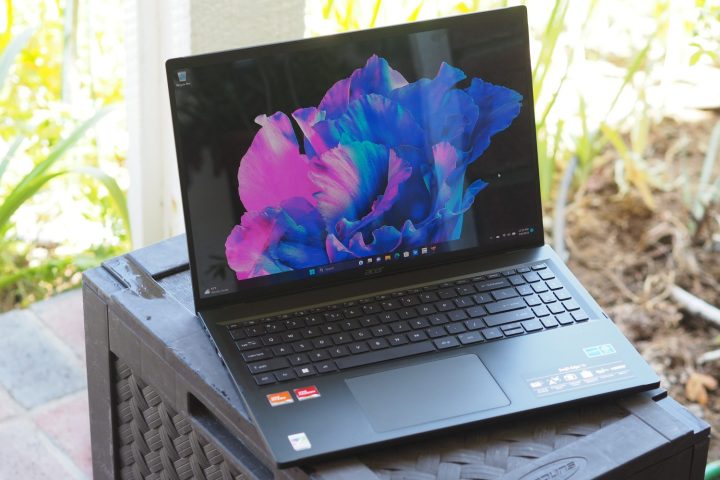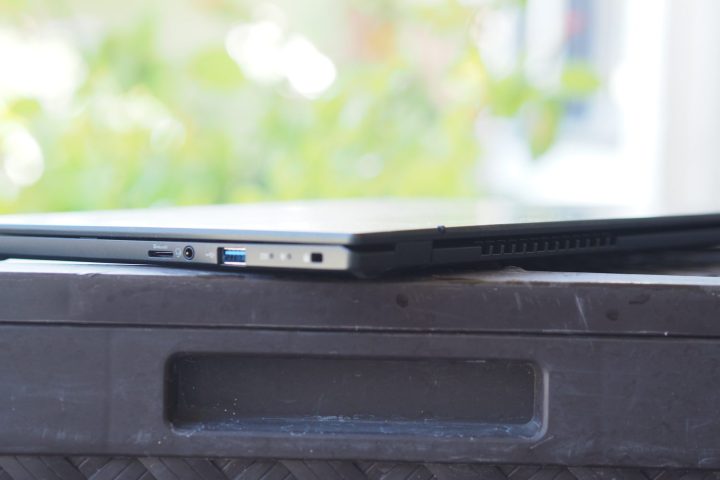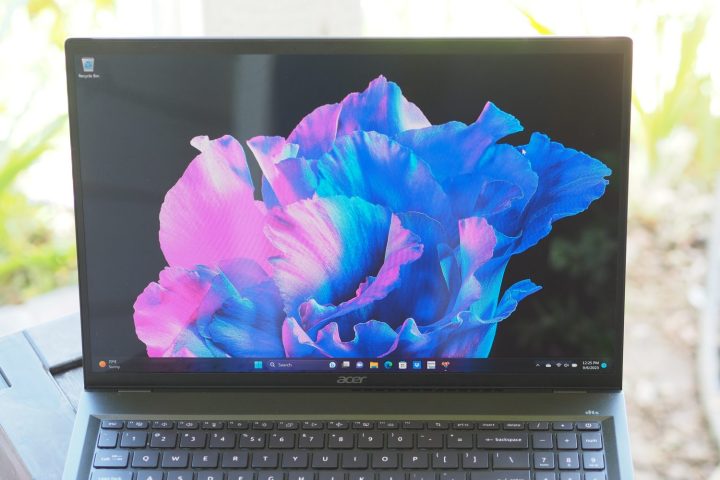
Larger laptops have become more popular as the industry adapts to the needs of hybrid workers and creators. But some users value portability over power, so a number of new thin and light 15-inch laptops and larger have hit the market to meet their needs.
Apple recently released its largest MacBook Air ever, the MacBook Air 15, which is incredibly thin and reasonably light. Acer has its Swift Edge 16, which is one of the lightest large laptops, but not quite as thin as the MacBook. Which of these machines is right for you?
Specs and configurations
| Acer Swift Edge 16 | Apple MacBook Air 15 | |
| Dimensions | 14.08 inches x 9.68 inches x 0.57-0.60 inches | 13.40 inches x 9.35 inches by 0.45 inches |
| Weight | 2.73 pounds | 3.3 pounds |
| Processor | AMD Ryzen 7 7840U | Apple M2 (8 cores) |
| Graphics | AMD Radeon graphics | 10-core GPU |
| RAM | 16GB | 8GB 16GB 24GB |
| Display | 16.0-inch 16:10 WQXGA+ (3,200 x 2,000) OLED, 120Hz | 15.3-inch 16:10 Liquid Retina IPS (2,880 x 1,864), 60Hz |
| Storage | 1TB SSD | 256GB SSD 512GB SSD 1TB SSD 2TB SSD |
| Touch | Yes | No |
| Ports | 2 x USB4 with Thunderbolt 4 2 x USB-A 3.2 Gen 1 1 x HDMI 2.1 1 x 3.5mm audio jack 1 x microSD card reader |
2 x USB-C with Thunderbolt 4 1 x 3.5mm audio jack |
| Wireless | Wi-Fi 6E and Bluetooth 5.1 | Wi-Fi 6E and Bluetooth 5.3 |
| Webcam | 1440p | 1080p |
| Operating system | Windows 11 | MacOS Monterey |
| Battery | 54 watt-hour | 66.5 watt-hour |
| Price | $1,300 | $1,299+ |
| Review | 4 out of 5 stars | 4.5 out of 5 stars |
The Acer Swift Edge 16 has one configuration with an AMD Ryzen 7 7840U CPU, 16GB of RAM, a 1TB SSD, and a 16.0-inch WQXGA+ OLED display for $1,300. That’s an attractive price for a large laptop with a spectacular display.
The MacBook Air 15 starts at $1,299 for an Apple 8-core CPU/10-core GPU M2 CPU, 8GB of RAM, a 256GB SSD, and a 15.3-inch Liquid Retina IPS display. The MacBook costs $2,499 with 24GB of
Design

Apple’s latest MacBooks have adopted a consistent design theme, with simple lines and angles, and the usual unibody aluminum construction that exudes elegance. The MacBook Air 15 maintains this aesthetic while being incredibly thin at just 0.45 inches, with small display bezels and a notch for the webcam that’s somewhat controversial. Still, it’s the thinnest 15-inch laptop around, and it’s relatively light at 3.3 pounds. The laptop also maintains the usual excellent Apple build quality, with a rigid chassis and lid, and a display that opens with one hand. You can buy the MacBook Air 15 in one of four colors: Silver, Starlight, Midnight, and Space Gray.
The Acer Swift Edge 16 is also an attractive laptop with a minimalist design, coming in a single black color that’s maintained throughout the chassis and lid, with just a chrome Acer logo breaking up the color scheme. It has small display bezels, but they’re plastic and detract from an otherwise modern and quality aesthetic. The Swift Edge 16 is one of the lightest large laptops around at just 2.73 pounds, and it’s reasonably thin at a maximum of 0.60 inches. Acer achieved this light weight by using magnesium-aluminum alloy, which is strong, but more flexible. That makes the Swift Edge 16 less rigid than the MacBook Air 16.
The MacBook Air 15 enjoys the best laptop keyboard, Apple’s Magic Keyboard, with its excellent key spacing and large keycaps and switches that have slightly shallow travel, but the snappiest and more precise response. The Swift Edge 16’s keyboard is comfortable enough, with plenty of key spacing and large keycaps and switches that are crisp and responsive. Even so, Apple’s keyboard is better. The MacBook Air 15 also has Apple’s Force Touch haptic touchpad, which gives users the ability to click anywhere on its large surface, as well as extra functionality built in. Acer’s mechanical touchpad is just OK, with a smaller surface area and sharp, quiet clicks.
Connectivity favors the Swift Edge 16, which has the same number of Thunderbolt 4 ports as the MacBook Air 15, but several legacy ports and a microSD card reader. Both laptops have up-to-date wireless connectivity.
Finally, the Swift Edge 16 has a higher-resolution webcam, at 1440p versus 1080p. Both laptops have fingerprint readers embedded in their power buttons for passwordless login.
Performance

The Swift Edge 15 uses AMD’s Ryzen 7 7840U, a 28-watt chip with eight cores and 16 threads running at up to 5.1GHz. It’s a fast CPU that outperformed the MacBook Air 15’s 8-core CPU/10-core GPU M2 processor in our CPU-intensive benchmarks. It’s possible that the MacBook Air 15 will be faster in applications that benefit from GPU optimizations, such as video- and photo-editing apps.
Both laptops are fast enough for demanding productivity tasks, but for most users, the Swift Edge 16 has an edge.
| Geekbench (single/multi) |
Handbrake (seconds) |
Cinebench R23 (single/multi) |
|
| Acer Swift Edge 16 (Ryzen 7 7840U) |
N/A | Bal: 86 Perf: 84 |
Bal: 1,790 / 10,560 Perf: 1,788 / 10,848 |
| MacBook Air 15 M2 (M2 8/10) |
Bal: 2,606 / 10,024 Perf: N/A |
Bal: 144 Perf: N/A |
Bal: 1,596 / 8,020 Perf: N/A |
Display and audio

While the MacBook Air 15’s Liquid Retina IPS display offers tons of brightness and fairly wide and accurate colors, the Swift Edge 16’s OLED display offers wider and more accurate colors and inky blacks. Our colorimeter was unable to measure the display’s contrast ratio, but it’s guaranteed to be in the 25,000:1 or so range that gives it deeper blacks than the MacBook Air’s display. Both are very sharp, but the Swift Edge 16’s panel benefits from a faster refresh rate of 120Hz.
All productivity users and all but the most demanding creators will love both displays. However, media consumers will appreciate the deeper blacks and additional detail provided by the OLED display.
| Acer Swift Edge 16 (OLED) |
MacBook Air 15 (IPS) |
|
| Brightness (nits) |
417 | 475 |
| AdobeRGB gamut | 100% | 100% |
| sRGB gamut | 98% | 90% |
| Accuracy (DeltaE, lower is better) |
0.63 | 1.23 |
| Contrast ratio | N/A | 1,200:1 |
The MacBook Air 15’s audio is superior, with six speakers and force-cancelling woofers that provide tons of volume, crystal-clear mids and highs, and more bass than most laptops. The Swift Edge 16’s dual-speaker audio just can’t keep up.
Portability

Due to its larger display, the Swift Edge 16 is slightly wider and deeper than the MacBook Air 15. It’s thicker at 0.60 inches versus 0.45 inches, but lighter at 2.73 pounds versus 3.3 pounds. Both laptops are highly portable for machines with such large displays.
Battery life is another matter entirely. The Swift Edge 16’s Ryzen CPU didn’t live up to the typical AMD efficiency, providing just 5.75 hours of web browsing before shutting down. The MacBook Air 15 hit an impressive 18.75 hours, tripling the Acer’s longevity. If all-day battery life, and then some, matters to you, then the MacBook Air 15 has a clear win.
| Acer Swift Edge 16 (Ryzen 7 7840U) |
Apple MacBook Air 15 (M2) |
|
| Web browsing | 5 hours, 41 minutes | 18 hours 48 minutes |
The MacBook Air 15 is more refined and lasts longer
The Swift Edge 16 is a great example of a thin and light large-display laptop. It’s incredibly light, provides solid performance, and its OLED display is superior. However, the MacBook Air 15 has a more elegant and refined construction, a better keyboard and touchpad, and incredibly long battery life. It’s worth the extra investment for most people.
For this category, battery life and construction win the day. That doesn’t means you should discount the Swift Edge 16, though. It’s not only much cheaper than the MacBook Air 15, but it also comes with a much nicer screen, better performance, and a wider selection of ports. The webcam is a plus as well, especially if you’re using the laptop for work.
Editors' Recommendations
- Best Apple deals: Save on AirPods, Apple Watch, iPad, MacBook
- The 5 best MacBooks for video editing in 2024
- The best MacBook to buy in 2024
- Best laptop deals: Save on the Dell XPS 14, MacBook Pro 16 and more
- Best MacBook deals: Get an Air for $605 and save on M3 MacBook Pro


